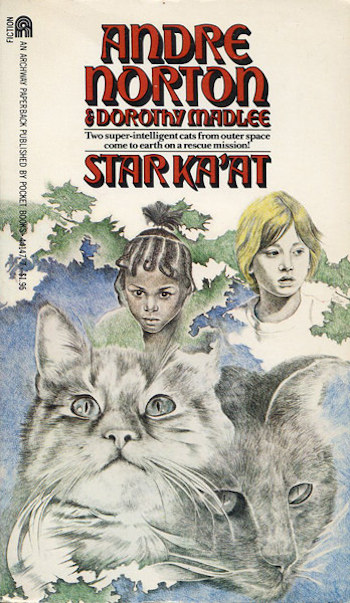As it turns out, I have actually read this volume in the series. I remember the big black cat with the white V marking, and the character named Elly Mae. The rest is lost in the mists of time.
This is what we now call a middle-grade book, with characters around ten years old. It’s a classic setup for the genre: offstage, disconnected adults, kids having their own adventures and doing their bit to save the world. These kids push standard Norton buttons, with the orphaned boy struggling to adapt to his new foster home, and the likewise orphaned girl raised in grinding poverty by her dying grandmother. The boy is white and the girl is Black, but they’re oblivious to racial politics. They have a prickly sort of friendship, as Jim tries to help Ellie cope in a world that has almost no place for her.
The really fun part is the titular species of sentient, telepathic, spacefaring cats, one of which is the big black male with the white V. He is a senior scout for his ship, and his subordinate, Mer, is basically a lilac point Siamese. Siamese cats aren’t nearly as common now as they were in the Seventies—they were popular then, and just about every cat person either had one or wanted one. (Ours were seal points, and mine had a kink in his tail.)
The Ka’ats colonized Earth millennia ago, and formed an alliance with humans in Egypt, where they were worshipped as gods. But humans evolved away from the ability to communicate telepathically and turned against their feline allies, who also devolved into nontelepathic domestic animals who (shudder) hunt and kill to eat. Ka’ats are not killers. They do apparently eat meat, as that’s what kitty kibble is a very highly processed form of, but that’s not a question the worldbuilding tries to answer.
Now the humans are about to blow up their world, and the Ka’ats have come to rescue as many of their distant kin as can hear and respond to their telepathic call. Scouts Tiro and Mer have embedded themselves with humans as part of their mission, Tiro with Jim and Mer with Ellie. As it turns out, Ellie is fully capable of “hearing” Mer’s telepathic communications, and Jim picks up enough to be a useful ally.
Buy the Book


To Sleep in a Sea of Stars
While the Ka’ats hasten to complete their mission before it’s too late, Ellie deals with her grandmother’s final illness and Jim tries to take care of Tiro after his foster father is called back to military service and his foster mother gets ready to ship herself and Jim to a family farm in Maryland. It all comes to a head one night, and Jim and Ellie have to choose between the human world and the Ka’ats’ flight back to space.
It’s fast-moving, gripping stuff, with engaging characters, especially the very cool Ka’ats. Tiro is a bit of a stickler for rules, and Mer is perfectly happy to be a rebel. They both end up in conflict with their leaders, but it works out in the end—more or less.
Although the novel was first published in 1976, it feels to me as if it’s more of a Sixties or even Fifties adventure. The consciously diverse protagonists are Seventies, but the fixation on humans blowing up the planet had started to ease off by then. The oil crisis was more of an issue, and we were headed toward the Iran hostage crisis and the Reagan Revolution. I actually had to check and be sure that this wasn’t first published a decade earlier. It has that Sixties vibe.
Other parts are striking now because of how different the world was before cell phones and helicopter parents. Jim’s foster mom is always off in the hallway talking on the phone, or if she’s interacting with him (usually to fret about the cat he’s adopted, or about moving to Maryland), the phone will ring and she’ll run off to answer it. It’s become a foreign concept to have a phone in a fixed location, that has to be answered when it rings—no voicemail or call forwarding, and apparently no answering machine, which is another reason for the retro vibe. Answering machines were a definite thing in the Seventies.
It’s just about as alien to see a pair of free-range kids. Ellie’s poverty forces her to fend for herself, to forage for junk and whatever food she can find, and she doesn’t seem to be enrolled in school, but privileged, well-off Jim doesn’t suffer from a great deal of parental surveillance, either. Mostly he has to show up for meals and be seen to go to bed at a particular time. What he does apart from that is pretty much up to him.
That was an interesting experience. So was my writer-brain’s reaction to the worldbuilding. A middle-grade book would tend to go for the simple in any case, but writer brain had questions. How does a species of cats, without thumbs or fingers, manufacture a spaceship? What or who builds them?
I expect at least part of that will be answered in the next volume, Star Ka’at World.
Judith Tarr’s first novel, The Isle of Glass, appeared in 1985. Since then she’s written novels and shorter works of historical fiction and historical fantasy and epic fantasy and space opera and contemporary fantasy, many of which have been reborn as ebooks. She has even written a primer for writers: Writing Horses: The Fine Art of Getting It Right. She has won the Crawford Award, and been a finalist for the World Fantasy Award and the Locus Award. She lives in Arizona with an assortment of cats, a blue-eyed dog, and a herd of Lipizzan horses.










